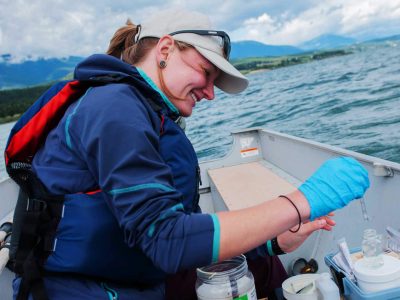The project that started it all!
Lake Windermere is the most heavily-used body of water in the entire Columbia Valley of southeast British Columbia, Canada. This shallow widening of the Columbia River is a water recreation “playground” AND a source of drinking water. Two communities are built around its shores: Invermere and Windermere. More than 50 per cent of the lakeshore has been disturbed or developed. Lake Windermere is fed by, and feeds, the Columbia Wetlands. These internationally-significant wetlands are a crucial part of the Pacific Flyway, one of the last intact resting and breeding habitats for migrating and resident birds in the greater region. Lake Windermere is very heavily used for motor-boating, sailing, windsurfing, canoeing, fishing and other recreational activities. On summer days there are often up to 200 power boats on the lake at the same time.
In recent decades, the lake’s ecology had suffered setbacks:
- Its population of burbot fish had collapsed;
- More than half of its shoreline had been degraded;
- And pollution — including gas, sewage and invasive plants — was on the rise.
Wildsight started the Lake Windermere Project in 2005 to create a water stewardship program that would last. This program - the Lake Windermere Project - resulted in the following successful outcomes:
- 5 years of scientific water quality monitoring has shown the lake is in good health;
- The highest ecological value habitats on the shoreline are now protected;
- Better planning is leading to better management through the new Lake Windermere Management Plan;
- Stewardship of the lake was taken over by the local community through the Lake Windermere Ambassadors Society, still very active today;
- Through this project, Wildsight became the Canadian branch of Living Lakes International, eventually morphing into Living Lakes Canada.
Windermere Project Named National Best-Practices Example in Community-Based Ecological Monitoring
The document below is a comprehensive report on the five-year Lake Windermere Project, and also serves as a water stewardship manual for use by the Lake Windermere Ambassadors and other lake stewardship groups across Canada.
Lake Windermere Project (2005-2010) Final Report
Lake Windermere Ambassadors
A group of committed citizens representing business, government, First Nations recreation, second homeowners, local residents, youth and non- government organizations whose mandate is the protection of the lake in perpetuity, the Lake Windermere Ambassadors direct future water quality monitoring and stewardship programs based on the success of the Lake Windermere Project. They encourage the implementing of policies, guidelines and recommendations resulting from the Lake Windermere Management Plan. Learn more in the video below.
Lake Windermere Project Timeline
- 2004, Wildsight hosts Living Lakes Conference:
The District of Invermere, Global Nature Fund and Wildsight host the 9th International Living Lakes Conference. The conference brings together experts from 35 organizations around the world. Special focus on the Columbia Wetlands and Lake Windermere and the need to protect our water resources while balancing the needs of people and wildlife. - 2005, survey highlights concern: Results of a 2005 Lake-Use Survey show public concern about Lake Windermere. People want to know more about septic systems, boat traffic, aquatic plants, shoreline and watershed development, water conservation and water quality.
- 2005, study recommends stewardship: The Regional District of East Kootenay commissions a Windermere Lake Water Quality Monitoring Program and Literature Review. It recommends more sampling with a five-year, community-based, water quality monitoring program. This is the basis of the Lake Windermere Project (LWP).
- 2005, the Lake Windermere Project starts: Wildsight develops the LWP. The goal is to protect and enhance water quality in the lake and its surrounding uplands. It grows into a partnership of government agencies, First Nations, organizations and local citizens.
- 2007, results of work so far: The B.C. Lake Stewardship Society completes a review: B.C. Lake Stewardship and Monitoring Program Windermere Lake 2005-2007. It gives an overview of the LWP and its results.
- 2008, Living Lakes superstars: Wildsight’s LWP and Columbia River Headwaters programs are used as case studies in capacity-building by other Living Lakes partners at the 12th International Living Lakes conference in Italy.
- 2008, Ambassadors step up: The Lake Windermere Ambassadors set up a way everyone can help out. Gold, silver or bronze: which are you?
- 2008, shoreline guidelines: The Lake Windermere Project and East Kootenay Integrated Lake Management Partnership digitally inventories Lake Windermere’s shoreline, creates Shoreline Management Guidelines and helps establish a two-year moratorium on foreshore development.
- 2009, Streamkeepers brought “on stream”: With funding from the Columbia Valley Community Foundation, LWP staff is trained and outfitted to offer Streamkeepers training to volunteers in early 2009. This means greater water stewardship capacity in the community.
- 2009, Lake Windermere, Canada and Lake Windermere, UK unite as “Sister Lakes” at the International Lakes for Living, Lakes for Life conference on the shores of Windermere, England.
- 2009: Sampling follows guidelines from the 2005 Windermere Lake Water Quality Monitoring Program and Literature Review (Masse & Miller 2005)
- 2010, Lake Windermere Project chosen as a “best practices” example for community-based environmental monitoring as part of a research project funded by the Canadian Environmental Assessment Agency (CEAA) and carried out by N.T.Yap Environmental Systems Analysts (YESA). View the initial paper entitled, Successful Community-based Monitroing in Canada: Three Case Studies.
- 2010, Full analysis of water quality results is completed by Ministry of Environment and used to update Water Quality Objectives for the lake, and provide background information for the Lake Management Plan.
- 2010, The Lake Windermere Project wins prestigious Land Award, given by the Real Estate Foundation of BC. The award recognizes innovation, collaboration and leadership related to sustainable land use and conservation in British Columbia.
- 2011, Regional District of East Kootenay and District of Invermere adopted the Lake Windermere Management Plan.The Plan guides long-term management of the lake and directs local government planning for the lake and shoreline. It considers and integrates the environmental, anthropogenic, cultural, and biological factors and values associated with Lake Windermere.
- 2011, Wildsight, the Lake Winnipeg Foundation and Global Nature Fund come together to create Living Lakes Canada, using the Lake Windermere Project as a model for successful community based lake stewardship.
- 2011, The Lake Windermere Project, now complete, is handed over to the community under the direction of the Lake Windermere Ambassadors, a group of committed citizens representing a broad sector of our community. The Lake Windermere Ambassadors are direct future water quality monitoring and lake stewardship education, and are working with the Regional District of East Kootenay and District of Invermere to implement the Lake Windermere Management Plan.




